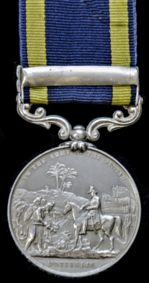Punjab Medal facts for kids
The Punjab Medal was a special award given to soldiers. It was for those who fought in the Punjab campaign of 1848-49. This was a war in the Punjab region (part of modern-day India and Pakistan). The war ended with the British taking control of the Punjab. The medal was created on April 2, 1849. It was given to all soldiers who served in the Punjab between September 7, 1848, and March 14, 1849.
What the Medal Looks Like
The Punjab Medal is a round silver medal. It is about 36 millimeters (1.4 inches) wide. A famous artist named William Wyon designed it.
Front and Back of the Medal
- The front of the medal shows the head of Queen Victoria. Her name, "VICTORIA REGINA," is written around her.
- The back of the medal shows a scene. It shows Sir Walter Gilbert accepting the surrender of the Sikh army. Above this scene, it says "TO THE ARMY OF THE PUNJAB." Below it, the year 1849 is written in Roman numerals (MDCCCXLIX).
How Medals Were Marked
- Each medal had the soldier's name and other details carved into it. This made each medal unique to the person who earned it.
The Medal's Ribbon
- The ribbon for the medal is about 31.7 millimeters (1.25 inches) wide. It is dark blue. There is a yellow stripe near each edge of the ribbon.
Medal Clasps
Clasps are small metal bars attached to the medal's ribbon. They show which specific battles or parts of a campaign a soldier took part in. For the Punjab Medal, three different clasps were created. However, no one received more than two clasps. This is because no soldier could have fought in both the Mooltan and Chilianwala battles.
If a soldier was in the Punjab but did not fight in one of the main battles, they received the medal without any clasps. The clasps are worn on the ribbon. They are placed downwards from the top of the medal. This is different from how most other medals show clasps.
Mooltan Clasp
- This clasp was for soldiers who fought in the siege of Multan. This battle took place from September 7, 1848, to January 22, 1849.
- About 18,967 of these clasps were given out. This included 2,900 to European soldiers and 16,067 to Indian soldiers.
Chilianwala Clasp
- This clasp was for soldiers who fought in the battle near Chilianwala. This battle happened on January 13, 1849.
- These soldiers were under the command of Lord Gough. They fought against the Sikh army led by Sher Singh and Lal Singh.
- About 21,453 of these clasps were given out. This included 4,300 to European soldiers and 16,153 to Indian soldiers.
Goojerat Clasp
- This clasp was for soldiers who fought in the battle at Goojerat. This battle took place on February 21, 1849.
- These soldiers were also under the command of Lord Gough. They defeated the Sikh army led by Sher Singh.
- About 32,960 of these clasps were given out. This included 6,200 to European soldiers and 26,760 to Indian soldiers.



